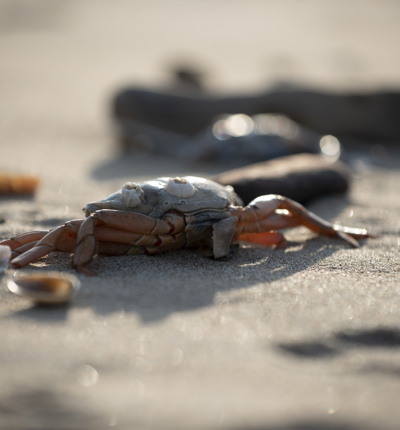
Conservationist secures commitment from DEFRA to carry out further investigation into dead crabs and lobsters on the northeast coast
The threat of legal proceedings by Whitby-based conservationist Joe Redfern has resulted in a commitment from Secretary of State for Environment, Food and Rural Affairs, George Eustace MP, to carry out further investigations into the cause of mass crab and lobster mortalities off the Teeside and Yorkshire Coast in 2021.
Posted on 31 August 2022
The further investigations will be carried out by the Department for Environment, Food and Rural Affairs (DEFRA) and the Centre for Environment, Fisheries and Aquaculture Science (CEFAS).
In October 2021, thousands of dead crabs and lobsters washed up on the Tees estuary and nearby north-east coast, prompting concern from environmentalists and fishermen that dredging activities in preparation for the North-east freeport may have caused harmful pollution to be released from sediment in the Tees estuary. The local fishing industry reported a 95% decline in the lobster and crab catch.
In a statement issued at the time, the Environment Agency (EA) said it was working with the CEFAS to investigate the underlying cause. In February 2022, DEFRA announced that following a “thorough investigation” with the EA, CEFAS and other agencies, it had concluded that “the deaths of the crabs and lobsters potentially resulted from a naturally occurring harmful algal bloom”. That conclusion was maintained in a final report published by DEFRA on 31 May 2022, entitled “Joint Agency Investigation into Teesside and Yorkshire Coast Crab and Lobster Mortalities”. The report concluded that the most likely cause of the unprecedented die-offs was a harmful algal bloom, despite the cold weather in October-December and the fact that no bloom had been noticed by any water users.
While the most significant mortalities of crabs and lobsters to date occurred in October to December 2021, smaller die-off events have occurred at frequent intervals since then, including throughout the time DEFRA and other agencies were investigating and a second large-scale die-off event in May 2022.
On 4 August, in a pre-action protocol letter to the Secretary of State for Environment, Food and Rural Affairs, George Eustace MP, Joe Redfern challenged the basis of DEFRA’s report, pointing out that many potential investigation leads were not followed. He argued that there had been an undue focus on the possibility of a harmful algal bloom to the exclusion of proper consideration of other likely causes, including a failure to test material dredged before and during the period in question for a chemical associated with industrial processes called Pyridine, alongside other contaminants.
After delaying its response to the pre-action letter, DEFRA now says that the report was not intended to present a final conclusion, but was instead a summary at the end of the first stage of investigation. While DEFRA maintains that its investigation showed no single source of Pyridine and that Pyridine was detected in crab samples outside of the known mortality area, DEFRA has now confirmed that the impact of Pyridine contamination is now “the subject of a full scientific study by CEFAS”. It is anticipated that the CEFAS investigation, and full dataset, will be published in autumn 2022. DEFRA has also committed to publish the evidence base for the existing report, although it is unclear at this point whether ongoing analysis will include testing dredged material for Pyridine.
On harmful algal blooms, DEFRA’s response notes that the species of algae that the report said had been indicated by satellite imagery (Karenia spp.) was “detected (in low numbers) from samples” but acknowledged that “it does not produce the two toxins identified” in tested crab tissue. DEFRA maintains, however, that another algae type (Dinophysis acuta) was found in water samples in November 2021 and in test crab tissue and that although it is not visible in satellite imagery it “can produce toxins at low concentrations”.
The legal case is now paused pending the publication of further data and analysis.
Reacting to DEFRA’s commitment to further investigation, Joe Redfern said:
“People living along the Northeast coast have been struggling to get to grips with the events that unfolded over the past few months. It has often felt like we had no support from the government agencies at all. Today we can count a victory that DEFRA is committing to further investigations, which we hope will be transparent and comprehensive. Moving forwards, we will aim to work together to find a cause and solution to the catastrophe.
“Many thanks to everyone involved with this campaign, those who have committed to keep working until we find the answer. Special thanks for Leigh Day and David Wolfe for their thorough and hard work.”
Joe is represented by solicitors Carol Day and Tom Short at law firm Leigh Day, and by counsel David Wolfe QC of Matrix Chambers.
Carol Day said:
“Our client welcomes DEFRA’s confirmation that this is not a final conclusion and that the results of ongoing investigation into the cause of the mass die-off will be published in the autumn. In order to be conclusive, DEFRA’s future investigation should include testing dredged material for Pyridine.
“It is essential that our client and relevant stakeholders are properly engaged in the ongoing investigation. This includes local experts, fishermen and environmental organisations with expertise in marine ecology and pollution.”
Joe is crowdfunding to support his campaigning via JustGiving.



